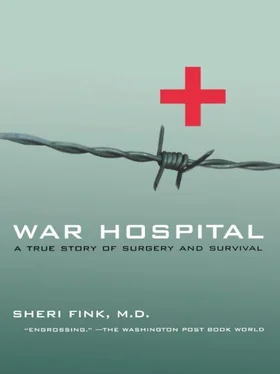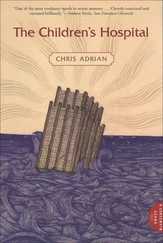Other Materials
Videotape footage from Srebrenica Hospital imprinted August 8, 1992, depicting several of the operations described in this chapter.
Notes
The events in the hospital on August 8 were reconstructed using a combination of videotape footage and the memories of the doctors and soldiers who participated in them. No existing medical records could be found to confirm the sequence of the operations.
CHAPTER 11: “DEAR DOCTOR”
Interviews
Dr. Rony Brauman, Dr. Eric Dachy, Guy Hermet, Dr. Vesna Ivančić, Laurens Jolles, Dr. Slavica Jovanović, Judith Kumin, Dr. Jean-Pierre Luxen, Fahreta Omić, Dr. Lazer Prodanović, Gerard van Driessche
Published Literature
Associated Press, November 27, 1992; BBC Summary of World Broadcasts (Radio Bosnia-Hercegovina), December 7, 1992; Christian Science Monitor, November 30, 1992 (“UN convoy relieves siege on Bosnia town,” by Jonathan Landay); DeKleva and Post, “Genocide in Bosnia,” pp. 485–496; Duizings, History, Memory and Politics in Eastern Bosnia ; The Economist, December 5, 1992; Financial Times, November 25, 26, 28, 30 (“Aid for Srebrenica after seven-month siege: Laura Silber arrives with the UN convoy bringing relief to a Moslem stronghold in Bosnia,” by Laura Silber), 1992; The Guardian , November 30, 1992; The Independent (London), November 7, 27, 28, 1992; Ivanišević, “Fate of the Serbs,” pp. 76–77 (testimony of Slavoljub Rankić, Serb survivor of December 14, 1992 attack on Bjelovac); The New York Times, November 29, 1992; Post and DeKleva, “The Odyssey of Dr. Radovan Karadžić”; Nelan, “Seeds of Evil”; Rieff, Slaughterhouse, p. 210; Silove, “The Psychiatrist as a Political Leader in War,” pp. 125–126; The Times (London), September 22, November 17, 27, 30, 1992; United Press International.
Documents
Eric Dachy’s unpublished chronicle of his experiences in the former Yugoslavia.
“UNHCR Update on Ex-Yugoslavia,” November 25 and December 1, 1992; MSF unpublished documents: Faxes from Eric Dachy to MSF Belgium Headquarters and MSF Yugoslavia task force December 6 and 12, 1992, reporting on the trip to Srebrenica and containing drafts of his letters to UNHCR and to Radovan Karadžić; Letter from Eric Dachy to Nedret Mujkanović, undated, delivered on December 10, 1992. UN document S/1994/674/Add.2 28 December 1994, Report of the UN Commission of Experts on the former Yugoslavia, Established Pursuant to Security Council Resolution 780 (1992), Annex 4, Part 6 (the “ethnic cleansing” campaign). World Medical Organization “Resolution concerning Dr. Radovan Karadžić,” adopted October 1996 (denounces Karadžić for failing to have turned himself in to the ICTY: “… as a physician he is bringing our profession into disrepute”).
Other Materials
The film Serbian Epics (1993, BBC TV, UK), directed by Paul Pawlikowski contains interviews with Radovan Karadžić and information on his family history. The physical descriptions of Karadžić are based on viewing this film.
Notebook found in Srebrenica Hospital labeled “Protokol Bolesnika,” containing a list of medicines provided to outpatients, was used to confirm doctors’ memories of the supplies they had in winter 1993. These included predominantly antibiotics, antiparasitics, painkillers, blood pressure and heart medications, diuretics, anti-nausea drugs, vitamins, and anti-anxiety drugs as would be expected after having received basic drug kits from MSF.
Notes
PAGE 89 Just before dying in 1992… This quote is from Armstrong and Forestier, “Ending the Balkan Nightmare” (Forestier’s study of Rašković and this quote are also discussed in Annex 4 of the U.N. Commission of Experts final report). Rašković is said to have spoken these words on Belgrade’s “Yutel” television station. I could find no other reference to confirm this information.
PAGE 90 “Dear doctor… ” The hypocrisy of Karadžić’s greeting outraged Eric Dachy, but in an interview he offered a different analysis, using his own knowledge of psychology. “Literally he was saying, ‘I would like to meet you in other circumstances.’ And he said it and addressed me as a doctor. Maybe he was expressing a deep wish, an unconscious wish, to be in better circumstances. I didn’t feel so at the time, but this occurred to me later. He was old. I was young. The whole world saw him as evil. I was representing good and he was representing evil and he must have felt it. This made me feel he had a soul, but he was simply hiding it. It was under a layer of brutality.”
PAGE 95 Patients have died… Srebrenica doctors recalled at least one diabetic patient having died for lack of insulin. Several patients with need for more sophisticated treatments also died early in the war, including those dependent on kidney dialysis.
PAGE 97 He sends the letter. The attack on December 14, 1992, took place in the towns of Bjelova and Loznička Rijeka.
PAGE 97 During the attack… Dr. Vesna Ivančić of the Bratunac health clinic, interviewed by the author in 1999, estimated one hundred and six wounded and seventy-six dead, including two medics.
Interviews
Mensur Gadžo, Hakija Meholjić, Dr. Nedret Mujkanović, Naser Orić, Dr. Simon Mardel, Dr. Ilijaz Pilav, Ibrahim Purković
Published Literature
Bosnia Country Handbook, p. 16–1 (anti-aircraft gun specifications); Mosby’s GenRx (entry for Ketamine Hydrochloride); Miller, Anesthesia, pp. 240–245; Naythons, The Face of Mercy, pp. 39–69; Orić, Srebrenica, p. 167; Mašić, Srebrenica, p. 65; Sudetic, Blood and Vengeance, p. 154, 157–161.
Documents
Unpublished World Health Organization documents: “Clinical Uses of Ketamine and Contraindications to Its Use,” and “The Use of Ketamine in Hospital Anaesthesia,” by Dr. Simon Mardel; the latter essay is contained in “Final Report of Dr. Simon Mardel W.H.O. Sarajevo, 1/28–6/1, 1993.”
CHAPTER 13: HOLIDAYS IN HELL
Interviews
Sabera Alić, Dr. Ejub Alić, Dr. Eric Dachy, Elvira Duraković, Muhamed Duraković, Samira Duraković, Hadžo Gadžo, Mensur Gadžo, Dr. Avdo Hasanović, Samira Hodžic, Dr. Vesna Ivančić, Dr. Fatima Klempić-Dautbašić, Hakija Meholjić, Dr. Nedret Mujkanović, Dr. Radomir Pavlović, Dr. Ilijaz Pilav, Ibrahim Purković, Naim Salkić, Emira Selimović, Rahima Tursunović-Ibrahimović, Philipp von Recklinghausen
Published Literature
Duizings, History, Memory and Politics in Eastern Bosnia, Chapter 1 (section on Kravica); Holbrooke, To End a War, p. 51; New York Times, February 11, 1993; Ivanišević, Hronika (pp. 55–56, 88–89, 160, 172–173, 323–329 Kravica; pp. 56–57; 161 Skelani); Malcolm, Bosnia, pp. 247–250 (Vance-Owen plan); Masić, Srebrenica (pp. 72, 112–113 Kravica; pp. 72–73 death of Nijaz Džanić; 114–115 Skelani); Orić, Srebrenica (p. 219 death of Sulejman Pilav; p. 164 death of Nijaz Džanić; p. 169 Kravica); Sudetic, Blood and Vengeance (pp. 161–164 Kravica offensive; pp. 171–172 Skelani offensive and killing of Serbs in Srebrenica).
Documents
UN document S/1991/548 (Serb casualties in vicinity of Srebrenica); copy of a Bosnian Army Second Corps document listing all wartime medical workers and information on doctors killed (title, date unknown). Data on U.S. healthcare workforce statistics for the early 1990s is from the U.S. Health Resources and Services Administration, Bureau of Health Professions. Data on Bosnia healthcare workforce statistics is from the WHO Regional Office for Europe.
Читать дальше












